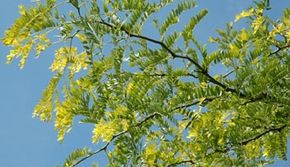Honey locust is a tall, pod-bearing, deciduous shade tree with a short trunk. Its ornamental foliage is lacy and medium to fine in texture. The tree's mature size is variable, growing in the 30 to 70-foot range, taller in the wild. Honey locust is a rapid-growing tree whose fall foilage is yellow to yellow-green. Its fruit is a long, reddish-brown, straplike, curved pod produced in late summer. Its shade is dappled and permits plant growth beneath the canopy.
Advertisement
How to grow: Plant honey locust in full sun and limey soil. It adapts to a range of conditions, including drought and high pH, and tolerates road salt spray.
Uses: To avoid thorns and litter problems, use an unarmed podless selection as a shade tree. Webworm is this plant's worst enemy. Leaflets are small and break down quickly.
Related varieties: Shademaster, a superior podless cultivar with a vaselike form, is fairly resistant to webworms. Skyline is noted for its golden fall color and upright form. Summergold has gold-green leaves in summer.
Scientific name: Gleditsia triacanthos var. Inermis
Advertisement
